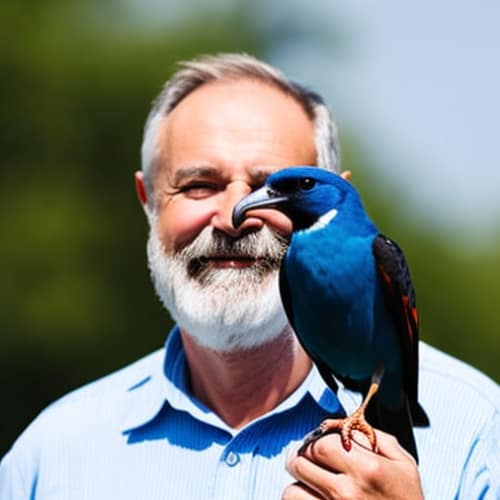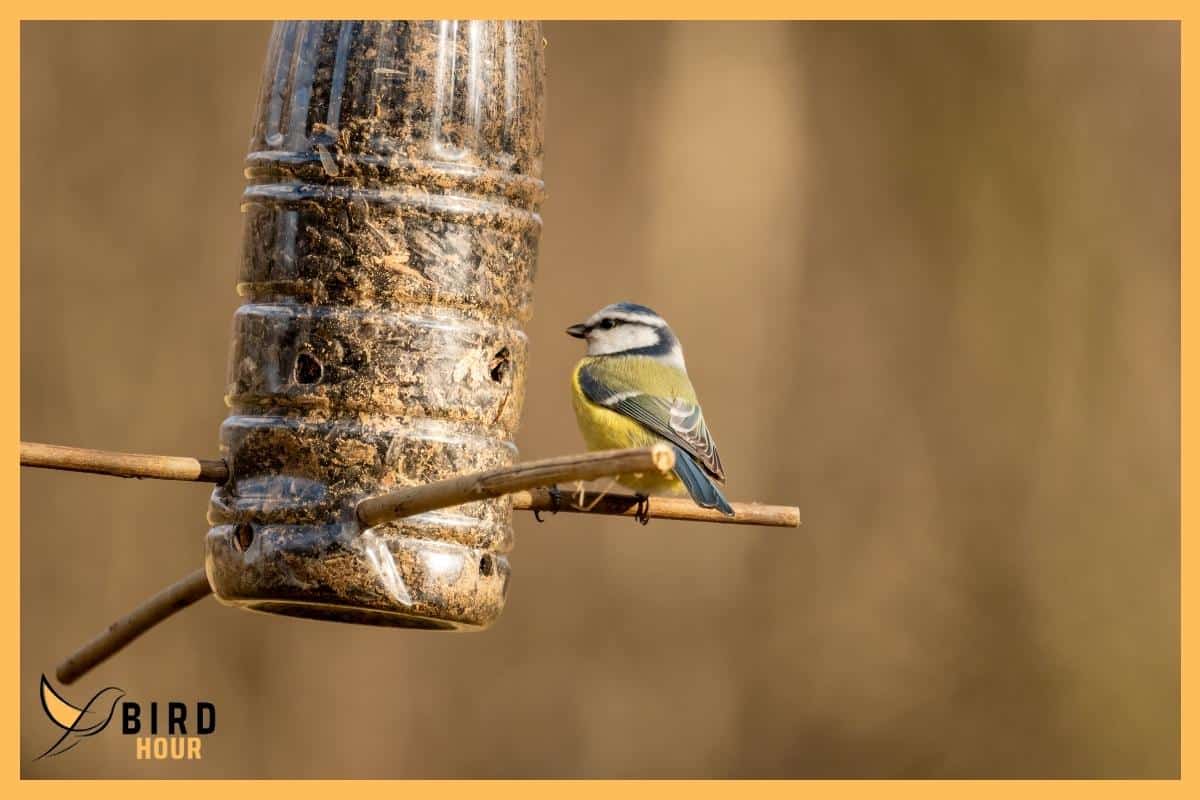Quick Answer:
There are many types of birds that are blue, including blue jays, bluebirds, indigo buntings, and blue grosbeaks. The color blue is produced by the reflection and absorption of light by the bird’s feathers, and is a result of the structural properties of the feather.
Have you ever wondered what kinds of birds are blue? From the vibrant feathers of a peacock to the striking iridescence of an indigo bunting, there’s no denying that some of nature’s most stunning creatures boast this stunning color. But which species have made it their signature hue? Let’s take a look at some of these remarkable feathered friends and learn more about why they’re so special.
From tiny hummingbirds to majestic macaws, many different types of birds can be found with shades ranging from azure to navy. These avian beauties often stand out in stark contrast against a backdrop of green foliage or brown branches – making them easy to spot! Whether gliding through the air or perched atop a branch, these gorgeous creatures are sure to bring delight when spotted in the wild.
But beyond their alluring appearance, there is much more than meets the eye when it comes to learning about our blue feathered friends. So let’s dive into discovering just what makes these birds so unique – and get up close and personal with some truly amazing animals!
Classification Of Blue Birds
We all know the sight of a bright blue jay, with its distinctive crest and telltale call. But the beauty of blues doesn’t end there – from indigo buntings to blue-winged kookaburras and beyond, these birds come in many different shapes, sizes and species. And then there are the iconic blue-footed boobies that inhabit tropical climates! All of these feathered wonders share one thing in common: they proudly display their vibrant hue as a badge of honor.
But what else do we know about blue birds? What characteristics set them apart? We’ll explore this further in our next section by looking at some remarkable traits found among these avian beauties.
Characteristics Of Blue Birds
Now that we have classified the different types of blue birds, let’s take a look at some of their characteristics. The most common type is the Blue Jay or Jaybird. This species has an unmistakable bright blue color and a black necklace around its neck. It also has white patches on its wings and tail feathers, making it stand out even more in the sky! Another popular species is the Blue Robin which is smaller than the Blue Jay but with similar features. Its head and throat are dark gray while its back and wings are light to medium shades of blue.
The third type of blue bird is called the Blue-Winged Warbler or Wood Thrush. This species typically lives in woodlands or shrub lands where they eat insects such as caterpillars and spiders along with small berries and seeds. They can be identified by their olive greenish upper parts and yellowish underparts combined with distinctive chestnut brown streaks across their breast area. Lastly, there is the Western Tanager which looks quite different from other blue birds due to its vibrant red head contrasted against its all-blue body plumage.
These four distinct species give us insight into how diverse these creatures can be when it comes to coloring and size, yet still share many similarities between them since they’re all part of the same family tree. Now let’s explore where exactly these beautiful feathered friends reside throughout our world for further understanding about distribution of blue birds in the world.
Distribution Of Blue Birds In The World
Take a look at the Eastern Bluebird, for example. This beautiful bird is found in North America, mainly east of the Rocky Mountains and along the Atlantic Coast. It has been spotted as far north as Canada and south to Florida. The Eastern Bluebird generally prefers open fields or grasslands with plenty of shrubs, so its habitat ranges can be quite extensive.
In addition to this species, there are several other bluebirds that have more specific range requirements. For instance, the Mountain Bluebird requires high elevation habitats with sparse conifers trees dotted throughout—areas like mountain meadows and alpine regions are perfect for these birds. Then there’s the Sialia genus which includes four different species: Western Bluebird, Mexican Bluewing, Azure-crowned Hummingbird, and Turquoise-throated Puffleg; all of which inhabit subtropical forests ranging from Mexico up through Central America into South America.
Migration patterns also play an essential role in where you find bluebirds around the world. Some migrate seasonally while others remain year-round residents despite changes in climate and food availability. But regardless of their migration habits, they all rely on safe nesting sites within their respective range areas so they can raise their young each season.
It’s clear that understanding how bluebirds distribute themselves across our planet is key to preserving them for future generations to enjoy. Their migratory routes must remain intact if we wish to keep spotting these stunning creatures wherever we go!
Feeding Habits Of Blue Birds
Having discussed the distribution of blue birds around the world, it’s time to explore their feeding habits. Bluebirds are a type of insectivore, meaning they primarily feed on insects and other invertebrates. Depending on where you live, your local bluebird population may vary in its food sources. Birdwatchers should consider what types of birdfeeders best suit their region when planning for bluebird-friendly habitats.
In terms of specific diets, some common things that bluebirds eat include mealworms, crickets, beetles and grasshoppers. They also consume fruits such as berries and cherries. Bluebirds will often visit suet or seed feeders set up by humans in order to supplement their diet with nuts and grains. It’s important to remember though that these supplemental foods shouldn’t make up more than 20% of a wild bluebird’s diet; otherwise it could lead to health issues down the line.
If you’re trying to attract bluebirds to your backyard habitat, here are some tips from experts: provide food sources near cover like trees or shrubs so they can easily hide if disturbed; keep feeders away from predators; offer a variety of food options; place multiple feeders in different locations throughout your yard; and be aware that different times of year call for different types of foods – in springtime caterpillars are ideal while winter months require sunflower seeds or suet cakes! With just a bit of effort, you can create an oasis for these beautiful creatures right in your own backyard!
Now that we know what they eat, let’s take a look at how blue birds reproduce…
Breeding Habits Of Blue Birds
Blue birds are fascinating creatures and their breeding habits can be quite interesting. There are several species of blue bird, each with its own unique habits when it comes to nesting, mating and raising young. Here is a list of three key elements that make up the breeding habits of blue birds:
- Nesting: Blue birds typically build cup-shaped nests from grasses and plant fibers in tree cavities or on ledges. They line the nest with feathers and other soft materials.
- Mating: The male will court the female by singing at her and showing off his colorful plumage before mating takes place. This courtship song may be repeated multiple times throughout the day until finally she accepts him as her mate for life.
- Raising Young: After eggs have been laid, both parents take turns incubating them for two weeks before they hatch. Once hatched, the chicks must stay in the nest for about two weeks while being fed by their parents until they fledge and become independent.
Although these behaviors provide insight into how blue birds breed successfully, there are still threats to their populations which need to be addressed in order to ensure their continued survival in our ecosystems.
Threats To Blue Bird Populations
It’s no secret that bluebird populations are in trouble. While some species of this iconic bird have seen a resurgence in recent years, others remain threatened by several external factors. In fact, researchers estimate that the global population of blue birds has decreased by more than 40% since the early 2000s due to various threats.
Habitat destruction is one of the biggest reasons for blue bird population decline. As humans continue to develop land and expand cities, their natural habitats shrink or disappear entirely. This leaves them with fewer places to nest and feed, ultimately leading to reduced numbers over time. Additionally, avian predation can also lead to reduced numbers of these birds as they become an easy target for larger predators like hawks and eagles.
Bluebirds also face competition from other species who may move into areas they once dominated. For example, European starlings were introduced to North America in 1890 which posed a significant threat to native species’ nesting sites and food supply sources. To make matters worse, climate change has caused drastic shifts in weather patterns worldwide making it harder for bluebirds—and all birds—to survive each year without adequate resources.
Clearly there are many obstacles standing between bluebirds and survival; however we still have hope if enough people step up and work together towards solutions like protecting existing habitat while creating new ones where possible or controlling invasive species through trapping or eradication programs. Hopefully then future generations will be able to enjoy these beautiful creatures just as much as we do today!
Conclusion
In conclusion, blue birds are some of the most stunningly beautiful creatures in nature. It’s no wonder they have been so revered throughout history and across cultures. But there is more to these fascinating birds than just their looks; their unique behaviors and habitats make them an important part of our planet’s ecology.
Unfortunately, many species of blue birds are threatened by human activities such as habitat destruction and climate change. If we want to preserve these majestic birds for future generations, then it is essential that we take action now to protect their habitats and reduce our impact on the environment. We can all do something – whether it be reducing our own carbon footprint or donating to conservation organizations. Our actions today will determine the future of these lovely creatures tomorrow!
Blue birds offer a special connection between us humans and nature: They remind us how beautiful this world is, how fragile its balance can be, and why we should strive to keep it safe for generations to come. Let’s work together to ensure that all kinds of blue birds remain around for years to come!

I am Bryan Powell and I own BirdHour.com. I love bird watching; in fact, I have a parakeet of my own. I enjoy spending time outdoors and observing the natural world around me. This website is a means of sharing my passion for birds with others who may be interested in this activity. Learn more about Bryan by viewing his full Author Profile.

